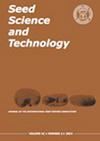辣椒种子炭疽病菌直接PCR检测方法的建立与验证
IF 3
4区 农林科学
Q2 AGRONOMY
引用次数: 2
摘要
采用直接聚合酶链反应(dPCR)技术,在炭疽病感染的辣椒种子中单独或作为一个疾病复合体检测了辣椒炭疽杆菌和辣椒炭疽杆菌。用C. cocodes和C. truncatum-s特异性标记物和Tris-EDTA缓冲液(从浸渍5小时的感染种子中获得)作为模板DNA的来源进行直接PCR。该方法以最低2.5%的侵染率高效、特异地检测到种子中各自的菌种,产生菌种特异性的~ 500 bp (C. truncatum)和~ 340 bp (C. coccodes)片段,而无需与其他分枝杆菌进行非特异性扩增。此外,实验中使用的种子与一套完整的干燥种子作为对照,测试了它们的发芽效率。在浸泡过的种子中,萌发率在50%(感染种子)到100%(健康种子)之间,没有任何显著的萌发损失,证实了当前方案的可持续性。我们建议使用直接从浸渍种子中提取DNA的直接PCR方法,作为直接从田间感染种子中检测病原体的一种经济、快速的方法。本文章由计算机程序翻译,如有差异,请以英文原文为准。
Development and validation of a direct PCR based assay for the detection of Colletotrichum species on chili seeds
An investigation was executed to detect Colletotrichum truncatum (synonymous C. capsici) and C. coccodes in solo or as a disease complex through direct PCR (dPCR) in anthracnose-infected chili seeds. Direct PCR was performed with C. coccodes and C. truncatum-s specific markers and Tris-EDTA buffer aliquots (obtained from infected seeds soaked up to five hours) as source of template DNA. This method efficiently and specifically detected the respective species in seeds with minimum 2.5% infection, yielding species-specific ∼500 bp (C. truncatum) and ∼340 bp (C. coccodes) fragments without any non-specific amplification with other mycoflora. Further, the seeds used in the experiment were tested for their germination efficiency along with a complete set of dried seeds as control. Among the soaked seeds, germination frequency ranged between 50 (infected seeds) to 100% (healthy seeds) without any significant loss in germination, confirming the sustainability of the current protocol. We recommend the use of direct PCR from soaked seeds without prior DNA extraction as a cost-effective and quick method for detecting the pathogen directly from infected seeds in fields.
求助全文
通过发布文献求助,成功后即可免费获取论文全文。
去求助
来源期刊

Seed Science and Technology
农林科学-农艺学
CiteScore
3.00
自引率
28.60%
发文量
36
审稿时长
>36 weeks
期刊介绍:
Seed Science and Technology (SST) is an international journal featuring original papers and articles on seed quality and physiology related to seed production, harvest, processing, sampling, storage, genetic conservation, habitat regeneration, distribution and testing. A journal that meets the needs of researchers, advisers and all those involved in the improvement and technical control of seed quality. Published every April, August and December.
 求助内容:
求助内容: 应助结果提醒方式:
应助结果提醒方式:


